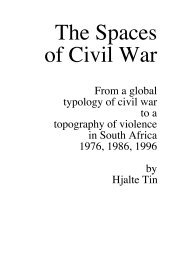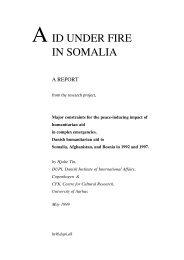wfp, food aid and local survival in guinea-bissau, 1998-99 - Nina ...
wfp, food aid and local survival in guinea-bissau, 1998-99 - Nina ...
wfp, food aid and local survival in guinea-bissau, 1998-99 - Nina ...
You also want an ePaper? Increase the reach of your titles
YUMPU automatically turns print PDFs into web optimized ePapers that Google loves.
Hjalte T<strong>in</strong> : Food Aid <strong>in</strong> Gu<strong>in</strong>ea-Bissau <strong>1<strong>99</strong>8</strong>-<strong>99</strong>. June 2001 ; page 7<br />
Ansumane Mané staged a new coup-attempt. He failed <strong>and</strong> was killed by troops loyal to<br />
the new president Koumba Yala.<br />
2/ THE WFP EMERGENCY OPERATION<br />
The humanitarian access<br />
In terms of humanitarian access to the population the war split Gu<strong>in</strong>ea-Bissau <strong>in</strong>to two<br />
different zones, Bissau <strong>and</strong> the ’regions.’ The frontl<strong>in</strong>e blocked l<strong>and</strong>, sea <strong>and</strong> air-access<br />
to Bissau untill mid-February 1<strong>99</strong>9. The N<strong>in</strong>o government had access only to Bissau, a<br />
small part of near-by Biombo prov<strong>in</strong>ce <strong>and</strong> the Bijagos isl<strong>and</strong>s. At the moment of<br />
maximum displacement, July <strong>1<strong>99</strong>8</strong>, this area conta<strong>in</strong>ed approximately 100-130.000<br />
displaced <strong>and</strong> war-affected persons <strong>and</strong> almost no non-affected groups. This part of<br />
Gu<strong>in</strong>ea-Bissau received practically no <strong>food</strong> supplies from the outside world before the<br />
end of March 1<strong>99</strong>9, <strong>and</strong> the population survived on stocks of <strong>food</strong> stored before the war<br />
by commercial traders <strong>and</strong> WFP. WFP left Bissau when the war began, return<strong>in</strong>g <strong>in</strong><br />
January 1<strong>99</strong>9.<br />
The Junta Militar had access to the rema<strong>in</strong><strong>in</strong>g 85% of the country conta<strong>in</strong><strong>in</strong>g<br />
approximately 200-310.000 displaced persons <strong>and</strong> the rest of the population number<strong>in</strong>g<br />
650-750.000. (WFP <strong>and</strong> G-B government figures for July <strong>1<strong>99</strong>8</strong>) The Junta Militarcontroled<br />
regions had no ports or airports of practical use, but road access from Senegal<br />
<strong>and</strong> Gu<strong>in</strong>ea Conakry. WFP was not evacuated from this part of Gu<strong>in</strong>ea-Bissau. Food<br />
consumed <strong>in</strong> the regions were <strong>local</strong> gra<strong>in</strong>s, imported rice bartered for cashew nuts <strong>and</strong> a<br />
small amount of <strong>food</strong> <strong>aid</strong>. Stocks of <strong>local</strong>ly produced <strong>food</strong>stuffs (rice <strong>and</strong> dry-l<strong>and</strong><br />
cereals) was at a m<strong>in</strong>imum <strong>in</strong> September-October before the harvest <strong>in</strong> November.<br />
WFP <strong>and</strong> the Gu<strong>in</strong>ea-Bissau emergency: remote geo-politics <strong>and</strong> few refugees






